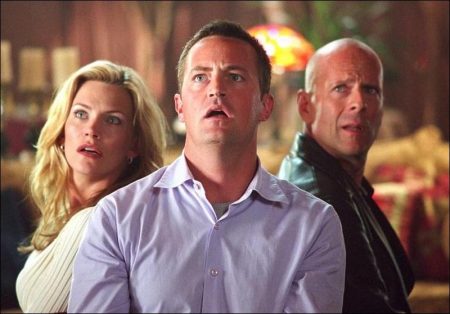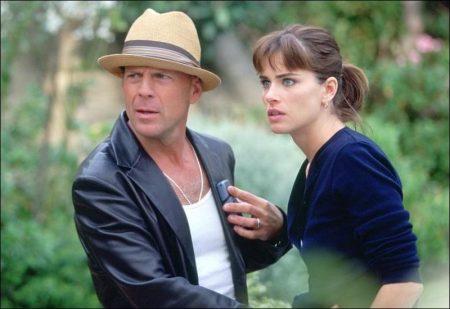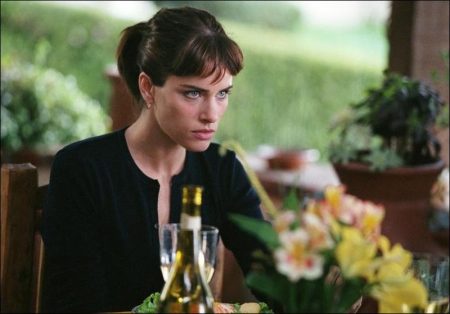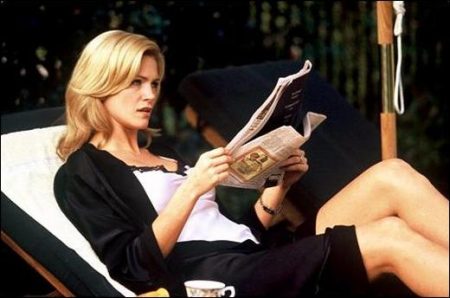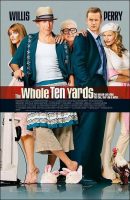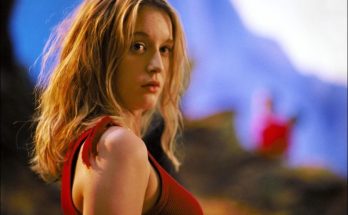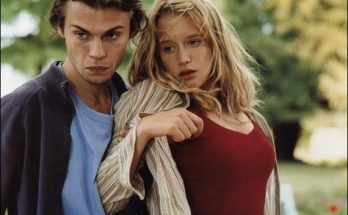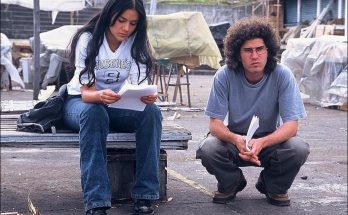Taglines: They missed each other. This time, their aim is better.
The Whole Ten Yards movie storyline. Retired hit man Jimmy “The Tulip” Tudeski (Bruce Willis) is enjoying the quiet life in a beachfront bungalow in Mexico. Thanks to falsified dental records supplied by onetime neighbor and friend Nicholas “Oz” Oseransky, D.D.S. (Matthew Perry) at the end of The Whole Nine Yards, Jimmy double-crossed the Gogolak gang and escaped the Feds by faking his own death.
Now, secure in his Baja hideaway, Jimmy has traded in his shotgun for a dust buster and is learning to channel his natural intensity into more domestic pursuits like cleaning, decorating and perfecting his culinary skills while working through some of the personal issues that led him to a life of crime.
The Whole Ten Yards is a 2004 American crime comedy film directed by Howard Deutch and sequel to the 2000 film The Whole Nine Yards. It was based on characters created by Mitchell Kapner, who was the writer of the first film. The film stars Bruce Willis, Matthew Perry, Amanda Peet, Natasha Henstridge, and Kevin Pollak. It was released on April 7, 2004 in North America. Unlike the first film, which was a commercial success despite receiving mixed reviews, The Whole Ten Yards was a major critical and commercial failure.
Unlike the first film, which was a commercial success, The Whole Ten Yards was a box office bomb, bringing in only $16,328,471 in North America and $9,827,310 internationally. With a worldwide total of $26,155,781, less than one-quarter the gross of the original, the film did not recoup its $40 million budget.
About the Film
The Whole Ten Yards was a result of spontaneous combustion when the original cast reconvened at the press junket for The Whole Nine Yards, nearly a year after wrapping production on the hit comedy. Most had not seen each other in the interim but they immediately fell into their former rapport and began to reminisce about the good times they had together shooting the film and developing their quirky characters. They imagined the kinds of situations these characters might find themselves in if there was a second installment to the story.
How would married life work out for newlyweds Oz and Cynthia, and how would notorious hit man Jimmy The Tulip take to his new role as a househusband? Will novice assassin Jill ever get the hang of, well, the hang of it? And was it really possible for Jimmy and Oz to expect that their whopping big lie about Jimmy’s death would go undetected forever or that either of them could ever really, truly, finally relax? Suppose it all comes back to bite them…
“The cast started kicking around ideas for another movie even before the first one came out,” says producer David Willis, one of the producers on the original film. “It started all of us thinking along the same lines.”
Once the actors had committed to reprising their original roles for part two, the producers handed the reins to director Howard Deutch, fresh from his 2003 DGA-nominated directorial effort Gleason. Adept at capturing the dynamics of on-screen comedy partnerships, Deutch counts among his credits The Odd Couple II and Grumpier Old Men, starring Hollywood legends Jack Lemmon and Walter Matthau. The director’s renowned sense of comic timing and his willingness to incorporate unscripted moments that might suddenly emerge from his active and collaborative cast made for a relaxed atmosphere where one joke would quickly spark another and it was up to Deutch to keep a firm grip on the story.
“I’m not a big believer in improvisation for its own sake,” Deutch explains. “I think it needs a foundation and basic parameters. But when a scene is making sense and fully grounded, then you can lift off and let the actors mess with it and have fun. They can capture the text and then elevate it with their own ideas and inspiration.”
Helping to provide that foundation is screenwriter George Gallo, who recently worked on Bad Boys II and is perhaps best known for the classic action comedy Midnight Run, in which tough guy Robert De Niro first showed off his comic talent. “The trouble with some sequels is that they almost do the same movie over again,” says Gallo, who began with the characters and story created by Whole Nine Yards screenwriter Mitchell Kapner and brought them into 2004.
“People change over time, and I wanted to know what happened to them since the last movie ended. Jimmy has retired and moved to Mexico where he has time to examine his life, have some kind of nervous breakdown and then develop this domestic passion that, presumably, keeps his old demons at bay – but barely. His former protégé, Jill, is now his wife and trying to launch her own career as a paid assassin but she’s not very good at it. Plus, she really misses their old life.”
Meanwhile, back in Los Angeles, “Oz is living in constant fear that the Gogolak gang he helped Jimmy double-cross will come back to get him,” adds Deutch. “He can’t help feeling that it’s not over yet and is constantly looking over his shoulder. He’s thinking about building a moat around his house. He’s got barbed wire, security cameras in every tree and every high tech gadget imaginable, trying to protect himself and his wife, who’s getting sick and tired of his mounting paranoia. The funny thing is, he’s right, but she won’t believe him.”
As much as Oz wants to avoid the Gogolaks, Jimmy wants to avoid anything connected with his former life – that is, his identity as a hit man, his association with the Gogolaks, his ex-wife Cynthia (now married to Oz) and, most definitely, his former friend and neighbor, Oz.
But old Lazlo Gogolak is about to shake up both of these not-so-happy homes. Recently paroled, the psycho septuagenarian has been in jail for years, brooding on the fact that Jimmy knocked off his favorite son, Yanni. He’s been plotting his revenge. Not satisfied with that whole dental-record-ID scam, he believes Jimmy is still alive and hiding somewhere. He also knows that Jimmy is smart and won’t be easy to track down so he goes for the obvious weak link in the operation – the hapless Oz – wisely assuming that “the dentist will lead us to the rat.”
Sure enough, after Lazlo and the boys kidnap Cynthia they watch the panicked dentist run for help to the only person he knows who can handle this situation: Jimmy The Tulip.
“But Jimmy has warned Oz that if he ever tries to contact him he’ll run over him with his car 20 times,” Deutch cautions. “He shouldn’t even think of calling. As far as Jimmy is concerned, everyone back home believes he’s dead and that’s the way he likes it. Clearly, he never wants to see Oz again, so when Oz shows up unannounced at the secret hideaway in Mexico, well, look out, it’s going to be a bad day for Oz.” “Friendship is over-rated. Besides, I’ve got enough friends. I’m looking to lose a few.” “The thing about Jimmy,” Deutch deadpans, “is that he’s funny and it’s okay to laugh at him and sometimes he’s laughing right along with you but you know he’ll kill you. Seriously. He will kill you. It’s what he does.”
Jimmy’s personality has evolved somewhat from what it was in The Whole Nine Yards. Although still “a stone cold killer, he’s now also a bit more sensitive and reflective. He feels some delayed guilt for his former way of life and is grappling with that and other issues that lead to some drunken epiphanies,” mostly in inappropriate moments, Deutch observes. “Plus, he has developed an obsession with his carpet and his cooking and it’s fun to watch these unexpected new dimensions emerging from a character we already know.”
In some ways, this chapter of their lives finds Jimmy and Oz switching some aspects of their original roles, notes Bruce Willis, in that “Jimmy’s given up the life of crime and is living in Mexico with his wife where he’s indulging his domestic side and his love for gardening, and Oz has become more of a tough guy who wants to save the day.”
Willis counts among his favorite scenes the one in which he and Perry drink two or three (or nine or ten) too many in a motel bar and his character generously insists on revealing some of his deepest secrets – whether his uneasy companion likes it or not. “That scene, and the following morning,” he admits, “is as far out, comedy-wise, as I’ve ever gone. Jimmy takes a pretty weird turn there and it was actually kind of disturbing…. but in a funny way.” Of course.
“Mixing it up is nothing new for Bruce,” offers producer Arnold Rifkin, who could be talking about how Jimmy accessorizes an apron and bunny slippers with a machine gun. Willis’ longtime agent and a partner in his production company, Cheyenne Enterprises, Rifkin easily calls up a series of successful vehicles for the versatile Emmy and Golden Globe-winning actor across a range of genres, “from Moonlighting and Blind Date to The Kid, from Armageddon and Die Hard to Nobody’s Fool, Pulp Fiction and The Sixth Sense.” He says that one of the prime motivations for Willis on The Whole Ten Yards was simply “to have fun with it. To get back to a character he really enjoyed playing, a bad guy who’s really not so bad, and to work with a talented ensemble cast he knew could lob the ball back from wherever he might hit it.”
The Whole Ten Yards (2004)
Directed by: Howard Deutch
Starring: Bruce Willis, Matthew Perry, Natasha Henstridge, Amanda Peet, Kevin Pollak, Tasha Smith, Elisa Gallay, Tallulah Willis, Johnny Williams, George Zapata, McNally Sagal
Screenplay by: George Gallo, Mitchell Kapner
Production Design by: Virginia L. Randolph
Cinematography by: Neil Roach
Film Editing by: Seth Flaum
Costume Design by: Rudy Dillon
Set Decoration by: Peg Cummings
Art Direction by: Sally Thornton
Music by: John Debney
MPAA Rating: PG-13 for sexual content, violence and language.
Distributed by: Warner Bros. Pictures
Release Date: April 9, 2004
Views: 101
